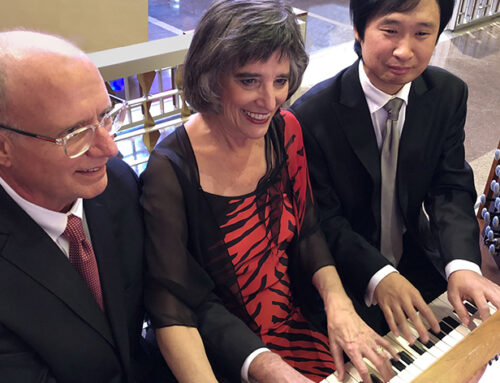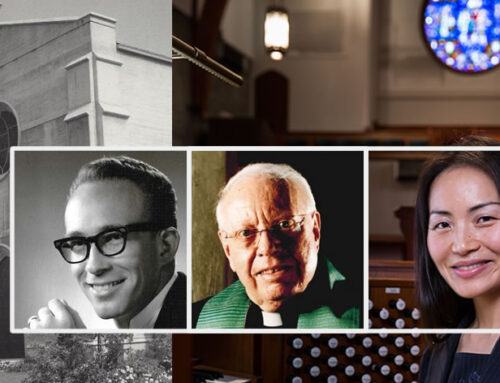College Years
The week after my high school graduation, I was hired as organist at Westwood Presbyterian Church. Thus began a wonderful, deepening journey into my relationship with God and the Church. I was at Westwood for nine years, spanning both my undergraduate and graduate years at USC and had the good fortune to work with two very fine and very different Directors of Music at Westwood. By accompanying and observing, I learned so much about the art of choral music during those years.
Westwood provided an amazing training ground — not only in church music but in theology. My mind and heart began to open in exciting ways. I heard challenging things about God’s love and justice and peace that I never heard at my home church. Sometimes it made me uncomfortable, a true sign of growth. A living faith, in the midst of doubt and ambiguity, was proclaimed. That was new to me, in the context of life in the church, where dogma is often prized over expansive thought and experience.
At this time, All Saints served as the USC organ studio for Cherry Rhodes. During my four-year study with Professor Rhodes, I came here every week for my lesson and gave my Master’s Recital here.
In 1982 I completed my master’s degree in organ performance. During that year I was also appointed College Organist at Occidental College.
Starting at All Saints
The associate organist job at All Saints became open, and I was encouraged to audition. I got the job and began in mid-February, 1983.
I was 26 years old and was hired, essentially, as an ace organist, with virtually no conducting duties, to accompany Coventry Choir (the one adult choir of about 35 members at the time) and to play major organ works, anthems and service music for the one primary Sunday morning service at 10:00.
It was pretty straight-forward and clear. It all sounded so very sweet, on paper….
I walked into my very first Coventry Choir rehearsal on the third Thursday of February 1983. The choir had been asked to come half an hour early, for a discussion led by the Rector, George Regas, with his executive assistant Anne Peterson and the one female priest on staff, Frannie Hall. The conversation engaged a controversy in the choir over a change in the text of a Rachmaninoff anthem from “Blessed is the Man” to “Blessed is the One.” It was a wonderfully strange, yet amazing discussion about the power of language, open-mindedness, change and inclusion. Observing the proceedings from a seat off to the side of the choir room, I thought, “What have I gotten myself into?”
Here I stand, 30 years later, asking the same question, and rejoicing in it, because this clearly is a church I want to be a part of, where there is a dynamic openness to exploring faith together, where we can search for truth and find our way to God in differing ways, and still come to the altar rail together.
A snapshot of All Saints liturgical life 30 years ago.
In 1983, as I mentioned, we had one adult choir and one sung service on Sunday mornings at 10am. Morning Prayer alternated with Eucharist. The printed liturgy we used each Sunday very roughly resembles what we use today. It was typed each week on an IBM Selectric typewriter, pasted together with rubber cement and run through the mimeograph machine. I still keep that Selectric typewriter in a corner of the music office, as a touchstone. We used the 1940 Hymnal as the primary source for our congregational singing. Even Christmas Eve was sweet — only two services (not four!): the 4pm family service and the 10:30pm with Coventry Choir and orchestra.
In the 1980’s, some things that we would absolutely take for granted were introduced into our liturgical life. For instance, it was not until the early 1980’s that a grand piano was permanently moved into the chancel of the church, allowing for a diversity of styles and much greater flexibility for experimentation. The phrase we used when we ventured into repertoire that didn’t originate in Europe was “experimental liturgy.”
Today, I believe those who worship at All Saints expect music from many cultures to be part of our liturgies every week. However, the process started gradually — adding one piece at a time — and has continued, in that way, all these years.



Leave A Comment